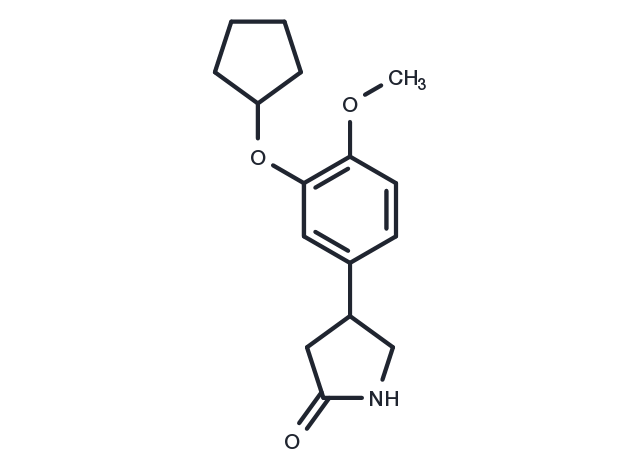Powder: -20°C for 3 years | In solvent: -80°C for 1 year


Rolipram (SB 95952) is a phosphodiesterase 4 inhibitor with antidepressant properties.

| Pack Size | Availability | Price/USD | Quantity |
|---|---|---|---|
| 10 mg | In stock | $ 43.00 | |
| 50 mg | In stock | $ 61.00 | |
| 100 mg | In stock | $ 87.00 | |
| 200 mg | In stock | $ 128.00 | |
| 500 mg | In stock | $ 212.00 | |
| 1 mL * 10 mM (in DMSO) | In stock | $ 48.00 |


| Description | Rolipram (SB 95952) is a phosphodiesterase 4 inhibitor with antidepressant properties. |
| Targets&IC50 | PDE4B:130 nM, PDE4D:240 nM |
| In vitro | The PDE4 selective inhibitor, Rolipram, inhibits immunopurified PDE4B and PDE4D activities similarly, with IC50s of approx. 130 nM and 240 nM respectively. In contrast, Rolipram inhibits immunopurified PDE4A activity with a dramatically lower IC50 of around 3 nM. Rolipram increases phosphorylation of cAMP-response-element-binding protein (CREB) in U937 cells in a dose-dependent fashion, which means that both high affinity (IC50 approx. 1 nM) and low affinity (IC50 approx. 120 nM) components are presented. Rolipram dose-dependently inhibits the IFN-gamma-stimulated phosphorylation of p38 MAPK in a simple monotonic fashion with an IC50 of approx. 290 nM[1]. Rolipram is a selective PDE4 inhibitor that inhibits all PDE4 isoforms A, B, C and D. Rolipram inhibits LPS-induced TNF production in a dose-dependent manner (IC50 25.9 nM), and maximal/submaximal inhibition is observed with 2 μM drug concentration in J774 cells[2]. |
| In vivo | In peritoneal macrophages (PM) from wild-type (WT) mice, lipopolysaccharide (LPS) induces TNF mRNA and protein expression, which is significantly reduced by Rolipram (by 74% and 63% for TNF mRNA and protein, respectively). However, LPS-induced TNF production is elevated in PM from MKP-1(-/-) mice compared to WT mice, aligning with existing research. Notably, Rolipram's ability to suppress TNF mRNA and protein levels in PM from MKP-1(-/-) mice is considerably weakened and lacks statistical significance. Furthermore, repeated Rolipram administration (1.25 mg/kg, i.p.) diminishes the incidence of escape failures in rats with learned helplessness, suggesting its potential therapeutic effect. |
| Cell Research | Rolipram is dissolved in DMSO and stored, and then diluted with appropriate medium before use[2]. J774 murine macrophages (ATCC) are cultured at 37°C in 5% CO2 atmosphere in DMEM supplemented with glutamax-1 containing 10% heat-inactivated FBS, 100 U/mL penicillin, 100 μg/mL streptomycin and 250 ng/mL amphotericin B. For experiments, cells are seeded on 24-well plates at a density of 2×105 cells per well. Cell monolayers are grown for 72 h before the experiments are started. Rolipram, IBMX and BIRB 796 are dissolved in DMSO, and 8-Br-cAMP in HBSS. LPS (10 ng/mL) or the compounds of interest at concentrations indicated or the solvent (DMSO, 0.1% v/v) are added to the cells in fresh culture medium containing 10% FBS and the supplements. Cells are further incubated for the time indicated. The effect of LPS and the tested chemicals on cell viability is evaluated by Cell Proliferation Kit II (XTT)[2]. |
| Synonyms | SB 95952, ZK 62711, (R,S)-Rolipram |
| Molecular Weight | 275.34 |
| Formula | C16H21NO3 |
| CAS No. | 61413-54-5 |
Powder: -20°C for 3 years | In solvent: -80°C for 1 year
Ethanol: 20.7 mg/mL (75 mM)
DMSO: 20.7 mg/mL (75 mM)
You can also refer to dose conversion for different animals. More
bottom
Please see Inhibitor Handling Instructions for more frequently ask questions. Topics include: how to prepare stock solutions, how to store products, and cautions on cell-based assays & animal experiments, etc.
Rolipram 61413-54-5 Metabolism Microbiology/Virology Proteases/Proteasome Antibacterial PDE HIV Protease SB-95952 Human immunodeficiency virus SB 95952 Inhibitor Bacterial ZK 62711 Phosphodiesterase (PDE) (R,S)-Rolipram ZK-62711 HIV inhibit ZK62711 SB95952 inhibitor
